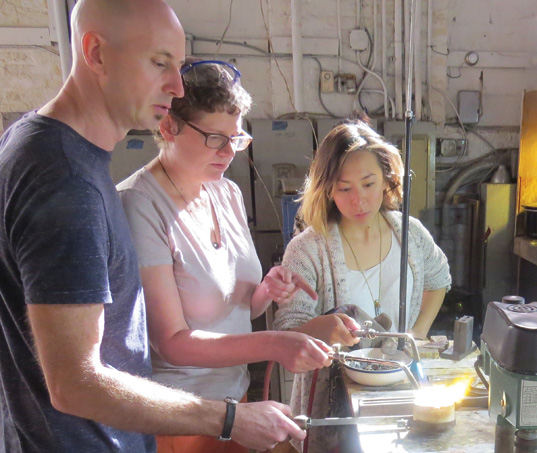|
Cover
From Button Factory to Brownstone
Customers discover a gallery, workshop and school at Fitzgerald Jewelry in Brooklyn, New York.
By Joyce Kauf
 | | Michael Fitzgerald, far left, and students. |
We offer the experience of seeing the product and the people who make it all in one room,” explains Michael Fitzgerald, who takes it one step further by offering classes at Fitzgerald Jewelry in Williamsburg, one of Brooklyn, New York’s, uber-hip neighborhoods. The gallery-store-school concept is integral to the retail philosophy of Fitzgerald and his wife Hiroyo, also a designer. Born in London and raised in Dublin, Fitzgerald specialized in metalwork at Dublin’s National College of Art and Design. However, it was when he attended Centro de Arte e Comunição in Lisbon, Portugal, that he was inspired to make both the fabrication and final product “extremely visible” to people. He returned to Dublin and founded a cooperative studio with other artists. Based on that success, Fitzgerald decided to translate that strategy across the Atlantic. In 1996, Fitzgerald opened Studio 174 in DUMBO, an acronym for Down Under the Manhattan Bridge Overpass. While there, he met Hiroyo, who was working at another design studio. But DUMBO was fast becoming too gentrified for them. Fitzgerald discovered an old button factory in Williamsburg, a decaying area that had been transformed by young people attracted by its once affordable rents and easy commute to Manhattan. In this 1,000-square-foot space, Fitzgerald created a side-by-side gallery and workshop. However, the factory is itself becoming a “victim of development” and is scheduled to be demolished. The new location, also in Williamsburg, is a 1,300-square-foot brownstone surrounded by boutiques and restaurants. Although the factory was an industrial setting, Fitzgerald remarks that its wood ceilings and concrete floors imparted a warm feeling. He kept some of the original features, including the steel doors and brick walls, combining them with modern display cases in steel and glass. Fitzgerald designed all the display cases, which were made in New York. The steel legs for the cases were created in the store’s metal workshop — as are the benches where students sit for the jewelry classes. “All of it is going to the new store,” says Fitzgerald.
Michael and Hiroyo’s designs are arranged by collection. The store represents local and international jewelers, including Vena Amoris, Davina Romansky and The Divine Tribe by Chad Ypon, as well as students who have gone on to become jewelers. Fitzgerald also holds exhibits two to three times a year. “We follow our own aesthetic,” explains Fitzgerald, a proponent of clean lines. “The richness comes from the materials and the presentation of the diamonds and gemstones.” Hiroyo, who was born in Japan, favors a more organic style of jewelry that plays with the sculptural quality of wax. She likes to combine different shades of gold with colored gemstones such as Malayan garnets with diamonds and black opals. Bridal accounts for approximately 60 percent to 70 percent of their work, much of it custom. Fitzgerald created his own split-bezel flush setting to focus on the stone and the line. Fitzgerald emphasizes that it is secure, but it eliminates the metal behind the diamond. He also recently introduced a melee collection of rings with about 12 stones per ring that “are quite old fashioned, but with a contemporary edge.” While white diamonds are “always the way to go,” Fitzgerald notes that colored diamonds, especially brown, chocolate and champagne, are popular, as are sapphires. He designs with tanzanite and tourmalines and recently introduced imperial topaz, but admits the jury is still out on its success. Over the past two years, opals have become strong sellers. “People are looking for a very personal experience when they commission a piece,” says Fitzgerald. Customers would come to him to source a diamond, but often the design they imagined was too impractical or too costly. As a result, Fitzgerald engaged a CAD designer, who is also a bench jeweler. “But it all starts with pen and paper,” he notes.
Fitzgerald credits word of mouth in an increasingly booming neighborhood as contributing to his success. But for the past ten years, Fitzgerald has exhibited at the twice-yearly Lincoln Center Crafts Fair, held in the shadow of New York City’s arts complex. This juried event attracts both residents and tourists and has been a boon for his business. “One couple who found me there commissioned an engagement and wedding ring. Now they come back each year. Others set up appointments at the gallery,” Fitzgerald points out. In addition to being an effective promotional tool, exhibiting also enables him to do market research. “I get to see people’s reaction to our new designs.”
Teaching was another idea from Fitzgerald’s days in Portugal, where students augmented their income by teaching. With courses for beginner to advanced, the school’s classes range from “Classic Ring” to “Painting a Bracelet” to “Gold: Recycling & Alloying.” Adamant that students gain an understanding of running a successful business, Fitzgerald also offers a course in creating marketing plans. The classes are held during business hours. “Customers love to see people with torches,” says Fitzgerald. Fitzgerald admits that he has adapted to changing customer tastes in terms of design and gemstones. But offering a gallery, workshop and jewelry-making classes in full view has been a distinct point of differentiation. “This model has been successful. I don’t see any reason to change it,” he concludes. Article from the Rapaport Magazine - February 2015. To subscribe click here.
|
|